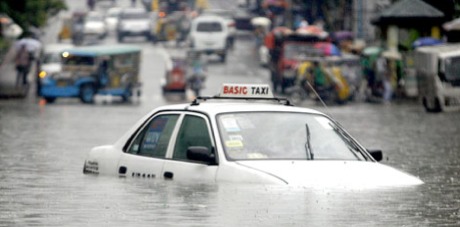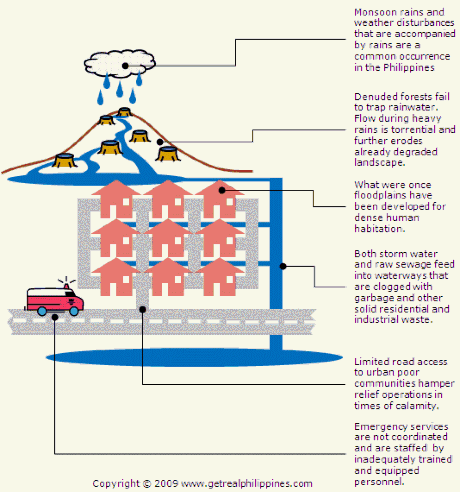So Metro Manilans, I hear, are stuck in traffic and floods this weekend. Again. And what’s this I hear? Oh, outrage. But where was that outrage when the problem was not this big yet and all there was were mere signs of problems brewing? I’ll tell you where that outrage was. There was none. In its place was laughter — that all-too-familiar sound Filipinos make when faced with what at the time are still surmountable problems.

[Photo courtesy Hindustan Times.]
I recall an observation made waaaay back by “an admired Filipino economist, based in New York” after she suggested that “What ails the country is that Philippine society is intellectually bankrupt”…
| SUPPORT INDEPENDENT SOCIAL COMMENTARY! Subscribe to our Substack community GRP Insider to receive by email our in-depth free weekly newsletter. Subscribe to our Substack newsletter, GRP Insider! Learn more |
There’s a weird culture in our midst: our jocular regard for our national problems, great crimes, villainous scams and calamities. Note that Filipinos are notorious for making fun, creating a joke of their misfortunes. The cellulars are full of them now. In other countries inhabited by serious and sensitive people, they mount crusades, indignation rallies or nationwide relief campaigns to meet such crises. They would weep or stomp their feet, or explode in anger, or demand punishment for the criminals or misfits. Here we tend to laugh at scams, crimes and natural calamities, as if they are part of the usual TV noon comedy shows, the Pinoy’s daily diet.
It’s very hard to be intellectual if you aren’t serious. And so far the clear evidence is that we are not a serious people. Worse, we don’t like to think.
Recall too how just a few years back, Filipinos were brimming with a palpable sense of mission to fix things after the devastation wrought by typhoon Ondoy back in 2009. Back then the so-called spirit of bayanihan was in the air — because in the aftermath of Ondoy was mayhem on a scale that defied even a collective imagination long seasoned by the consistent wretchedness of its existence.
Perhaps there is no such devastation and loss of life today (at least within the awareness of the chattering classes) as heavy rains once again pound much of Metro Manila and turn its teeming streets into steaming swampland. But the irony in the way some people simply laugh off this sorry state of the premier city of the country is lost as usual in our collective failure of imagination. While we have already been witness to a demonstration of how easily Manila could be destroyed by a storm even just a wee bit more powerful than Ondoy, the fact that the capital city today is once again paralysed by a far weaker tropical weather condition attests to how little was actually achieved despite all the post-Ondoy huffing and puffing.
In a show of the characteristic prescience of the average Get Real Post writer, I offered back then something that usually reveals itself in hindsight to the average schmoe…
For now, most of Ondoy‘s flood victims are surviving on a steady supply of relief goods organised by the resource-rich. When the collective guilt has been absolved, the call to return to business-as-usual starts to overshadow the call to temporary duty, and the images of people “helping out†on Facebook become commoditised, what is an unsustainable pipeline of supplies to begin with reduces to a mere trickle. Eventually everyone moves on — the rich withdraw back into their gated communities and the poor move back into the floodplains. Next disaster, plez.
Next disaster, plez.
Thankfully the only disaster we see today (at least within the radars of our “social media activists”) are a few poor souls who may have been deprived of a chance to see The Dark Knight Rises (which I may as well say now is el primo excellente, me having just come home after a really pleasant ten-minute drive from the local theatre).
Seriously (something we should have been 30 years ago when Manila was still not the human cesspool it is today), we can never remind people enough of what the systemic issues are behind what to a tiny elite minority of Metro Manila’s residents is the mere annoyance of flood-induced heavy traffic. It is really the result of decades of Pinoy-style thinking coming back to bite us…

[See originally-sized graphic and/or download as PDF here.]
Thousands of Filipino lives have been lost and millions of dollars in property damage sustained as a result of disasters caused by weather disturbances common in the region. Much of what contributes to the devastation are the result of years of neglect and lack of foresight. This means that measures can be taken now that can reduce the impact to lives and property of future natural calamities.
It’s time we see our vulnerability to natural calamities as a system of contributing factors and not just mere laughing matter.
- This latest Filipino-style ‘anti-corruption’ circus proves that the Philippines needs a serious reboot - November 16, 2025
- Filipinos literal sitting ducks as wind and floods from natural tropical typhoons amplified by years of neglect bear down - November 9, 2025
- Rally NA NAMAN??? - September 20, 2025
When the majority of metro-manila’s residents pay their taxes accurately, maybe that is the time that they can really raise hell and put the heat on those responsible.
Hi guys i pay over 26,000 in taxes and proud to do so but my guess is only 10% is used for projects helping the people at all 90% is fee to the system of you know what
Back then during the time of Typhoon Ondoy. The Aquino propaganda Media was putting it on the front page of the news. Blaming the previous administration. Now, that they are in power. They suppress or hide the news of the Metro Manila flood. They have not done anything, to solve the yearly flood problems. This is one of the weakness of Filipinos; they just accept what is given to them. Lousy governance, incompetent leaders, lying and deceiving politicians…they don’t care. We have already descended into this unimaginable apathy, that is working against all of us…
Hey, that taxi stuck in the water happened near where I live, the V. Luna area. Thank goodness I don’t pass there. hehe
To echo what I’ve been preaching in several forums…
http://www.pinoyexchange.com/forums/showthread.php?t=546747&page=2
[quote]….the cause of flood can be explained by science and engineering analysis of hydrologic processes:
1.) Precipitation (rainfall intensity) exceeds the rate of absorption of natural ground and the vegetation cover (infriltration) and the environments’ capacity to evaporate (evapo-transpiration) its ambient water/moisture thus producing excess rainwater in the surface (surface run-off)
2.) Due to natural terrain (topography), surface run-off and infiltrating water (groundwater) will flow to the lowest portion either to the sea/ocean or basins (lakes/ponds/). The transportation mechanism will be the following:
2a.) For surface run-off, by drainage (gravity flow) through natural conduits and waterways (i.e. rivers and its tributaries)
2b.) For groundwater, by percolation to the aquifer/aquitard/aquifuge.
3.) Flood occurs when either or in any combination of the following conditions are satisfied:
3a.) The intensity of rainfall exceeds the capacity of natural or catchment basins (eg.lakes, flood plain, dams / reservoirs) to contain the volume thus the overflow of surface run-off.
3b.) The intensity of rainfall exceeds the rate of infiltration/percolation to the ground, and it also exceeds the capacity of the aquifer/aquitard/aquifuge to store water, thus surface run-off.
3c.) The rate of flow of surface run-off to natural conduits exceeds the capacity of the waterways to discharge/drain to the basins/lakes or open sea/oceans.
3d.) Extreme change in weather patterns such as strong storm surges, and increasing mean sea level.
The parameters therefore for flood to occur are:
A.) Capacity to contain surface run-off.
Factors:
-Insufficient reservoirs
-Lack of retention ponds/lakes
B.) Capacity to store surface run-off
Factors:
-Insufficient water sheds and vegetative cover (deforestation, indiscriminate land conversion, etc.)
-Surface run-off not percolating to the ground aquifer/aquitard/aquifuge
-Ingress of saline water to the groundwater aquifer/aquitard/aquifuge due to grounwater drawdown or pumping from development areas (eg. residential subdivision using groundwater pumps)
C.) Capacity to discharge surface run-off
Factors:
-Inefficient sewer/stormwater network and system
-Diminishing natural waterways due to economic development (eg. riverside development, informal settlers)
-Clogged waterways either by garbage or siltation
D.) Climate Change
Factors:
– Change in weather patterns (extended and/or wetter rainy season, extended and/or drier/hotter summers)
– Rising sea levels
– etc.
=================================
Having defined the parameters for flood to occur, the structural solution therefore should address each or in any combination of the following parameters as described above:
A.) Capacity to contain Surface Run-off
– Typical solutions are as follows:
a.1) Provision for dams and reservoirs
a.2) Provision for retention ponds & lakes
B.) Capacity to store
-Typical solutions are as follows:
b.1) Watersheds and vegetative cover (i.e. trees)
b.2) Artificial Recharging wells
b.3) Swales
C.) Capacity to discharge
-Typical solutions are as follows:
c.1) separate network for each of the stormwater, residential sewer and industrial sewer lines.
c.2) increasing waterways’ capacity either, or in any combination of the following: dredging the river bed, widening the waterways, raising the embankment by providing dikes or levees.
c.3) reduce the potential of siltation and scouring either or in any combination of the following: bioswales along embankment, baffle chutes to reduce velocity, riprap/gabions/rock armours along embankment, etc.
c.4) diversion for other purposes such as irrigation, power generation, water supply, transportation, etc.
D.) Climate Change
– Typical solutions include:
d.1) Scenario Planning
d.2) Improved forecasting techniques
d.3) Infrastructure adaptation
The above solutions should be part of a comprehensive water management framework (i.e. policy development) in a regional or national scale and should be incorporated in the land use zonation planning, natural hazard & disaster risk mitigation plan, infrastructure development plan, and economic development plan of the region concerned.
Let us demand our local (city/municipal/provincial) and national (congressmen/senators) policy makers to provide the above needed solution and act quickly (in the same manner as they swiftly signed the impeachment of COrona).
[/quote]
Guess what!
Baha na naman!
…and where is the outrage!?